An Incentive Based Dynamic Pricing in Smart Grid: A Customer’s Perspective
Abstract
1. Introduction and Background
2. Related Work
3. Motivation
4. Contribution
5. Characterizing DR
6. System Model
6.1. Previous Model
6.2. Demand Aware Prices (Case-1)
6.3. An Incentive Based Price Overview (Case-2)
6.4. An Incentive Based Price Calculation
7. Proposed Algorithm
| Algorithm 1: Steps involved in calculating incentives using GA. |
|
8. Results and Discussion
9. Conclusions
Author Contributions
Funding
Institutional Review Board Statement
Informed Consent Statement
Data Availability Statement
Acknowledgments
Conflicts of Interest
Nomenclature
| t | index of time |
| i | index of loads |
| j | index of customers |
| number of arrival requests | |
| load demand of ith load | |
| load index for ith load | |
| energy consumption price of ith load | |
| binary decision variable | |
| actual price charged to M customers | |
| total energy consumption cost | |
| utility revenue | |
| scheduled load of jth customer | |
| min. limit on load demand of jth customer | |
| electricity price over time t | |
| utility cycle of ith load | |
| electricity price using proposed method | |
| actual electricity price phase-1 | |
| total electricity cost of ith load | |
| actual electricity price phase-2 | |
| actual electricity price after incentives | |
| electricity price after scheduling | |
| approximate cost difference | |
| incentives for customer | |
| unscheduled load jth customer | |
| max. limit on load demand of jth customer | |
| utility load |
References
- Baimel, D.; Tapuchi, S.; Baimel, N. Smart grid communication technologies-overview, research challenges and opportunities. In Proceedings of the 2016 International Symposium on Power Electronics, Electrical Drives, Automation and Motion (SPEEDAM), Capri, Italy, 22–24 June 2016; pp. 116–120. [Google Scholar] [CrossRef]
- Siroky, J.; Oldewurtel, F.; Cigler, J.; Privara, S. Experimental analysis of model predictive control for an energy efficient building heating system. Appl. Energy 2011, 88, 3079–3087. [Google Scholar] [CrossRef]
- Konda, S.R.; Mukkapati, B.; Panwar, L.K.; Panigrahi, B.K.; Kumar, R. Dynamic Energy Balancing Cost Model for Day Ahead Markets with Uncertain Wind Energy and Generation Contingency under Demand Response. IEEE Trans. Ind. Appl. 2018, 54, 4908–4916. [Google Scholar] [CrossRef]
- Peizhong, Y.; Xihua, D.; Abiodun, I.; Chi, Z.; Shufang, L. Real-time oppertunistic scheduling for residential demand response. IEEE Trans. Smart Grid 2013, 4, 174–227. [Google Scholar]
- Aslam, S.; Khalid, A.; Javaid, N. Towards efficient energy management in smart grids considering microgrids with day-ahead energy forecasting. Electr. Power Syst. Res. 2020, 182, 106232. [Google Scholar] [CrossRef]
- Xue, K.; Yang, Q.; Li, S.; Wei, D.S.L.; Peng, M.; Menmon, I.; Hong, P. PPSO: A Privacy-Preserving Service Outsourcing Scheme for Real-Time Pricing Demand Response in Smart Grid. IEEE Internet Things J. 2019. [Google Scholar] [CrossRef]
- Zhang, H.; Yue, D.; Dou, C.; Li, K.; Xie, X. Event-Triggered Multiagent Optimization for Two-Layered Model of Hybrid Energy System with Price Bidding-Based Demand Response. IEEE Trans. Cybern. 2021. [Google Scholar] [CrossRef] [PubMed]
- Ding, T.; Qu, M.; Amjady, N.; Wang, F.; Bo, R.; Shahidehpour, M. Tracking Equilibrium Point under Real-time Price-Based Residential Demand Response. IEEE Trans. Smart Grid 2020. [Google Scholar] [CrossRef]
- Ozturk, Y.; Senthilkumar, D.; Kumar, S.; Lee, G. An intelligent home energy management system to improve demand response. IEEE Trans. Smart Grid 2013, 4, 694–701. [Google Scholar] [CrossRef]
- Nguyen, D.H.; Narikiyo, T.; Kawanishi, M. Optimal Demand Response and Real-Time Pricing by a Sequential Distributed Consensus-Based ADMM Approach. IEEE Trans. Smart Grid 2018, 9, 4964–4974. [Google Scholar] [CrossRef]
- Gholian, A.; Mohsenian-Rad, H.; Hua, Y. Optimal Industrial Load Control in Smart Grid. IEEE Trans. Smart Grid 2016, 7, 2305–2316. [Google Scholar] [CrossRef]
- Golmohamadi, H.; Keypour, R.; Bak-Jensen, B.; Pillai, J.S.R. A multi-agent based optimization of residential and industrial demand response aggregators. Int. J. Electr. Power Energy Syst. 2019, 107, 472–485. [Google Scholar] [CrossRef]
- Rasheed, M.B.; Javaid, N.; Malik, M.S.A.; Asif, M.; Hanif, M.K.; Chaudary, M.H. Intelligent Multi-Agent Based Multilayered Control System for Opportunistic Load Scheduling in Smart Buildings. IEEE Access 2019, 7, 23990–24006. [Google Scholar] [CrossRef]
- Asgher, U.; Rasheed, M.B.; Al-Sumaiti, A.; Rahman, A.; Ali, I.; Alzaidi, A.; Alamri, A. Smart Energy Optimization Using Heuristic Algorithm in Smart Grid with Integration of Solar Energy Sources. Energies 2018, 11, 3494. [Google Scholar] [CrossRef]
- Yang, J.; Zhao, J.; Wen, F.; Dong, Z. A Model of Customizing Electricity Retail Prices Based on Load Profile Clustering Analysis. IEEE Trans. Smart Grid 2018. [Google Scholar] [CrossRef]
- Darby, S.J. Load management at home: Advantages and drawbacks of some active demand side options. J. Power Energy 2012, 227, 9–17. [Google Scholar] [CrossRef]
- Yoon, J.H.; Baldick, R.; Novoselac, A. Dynamic demand response controller based on rea-time retail price for residential buildings. IEEE Trans. Smart Grid 2014, 5, 121–129. [Google Scholar] [CrossRef]
- Chiu, T.C.; Shih, Y.Y.; Pang, A.C.; Pai, C.W. Optimized Day-Ahead Pricing with Renewable Energy Demand-Side Management for Smart Grids. IEEE Internet Things J. 2017, 4, 374–383. [Google Scholar] [CrossRef]
- Ridoy, D.; Wang, Y.; Putrus, G.; Kotter, R.; Marzband, M.; Herteleer, B.; Warmerdam, J. Multi-objective techno-economic-environmental optimisation of electric vehicle for energy services. Appl. Energy 2020, 257, 113965. [Google Scholar]
- Martirano, L.; Habib, E.; Parise, G. Demand Side Management in Microgrids for Load Control in Nearly Zero Energy Buildings. IEEE Trans. Ind. Appl. 2017, 53, 1769–1779. [Google Scholar] [CrossRef]
- Adika, C.O.; Wang, L. Demand-side bidding strategy for residential energy management in a smart grid environment. IEEE Trans. Smart Grid 2014, 5, 172–1733. [Google Scholar] [CrossRef]
- Rasheed, M.B.; Javaid, N.; Ahmad, A.; Khan, Z.A.; Qasim, U.; Alrajeh, N. An efficient power scheduling scheme for residential load management in smart homes. Appl. Sci. 2015, 5, 1134–1163. [Google Scholar] [CrossRef]
- Rasheed, M.B.; Javaid, N.; Ahmad, A.; Jamil, M.; Khan, Z.A.; Qasim, U.; Alrajeh, N. Energy optimization in smart homes using customer preference and dynamic pricing. Energies 2016, 9, 593. [Google Scholar] [CrossRef]
- Chen, X.; Wei, T.; Hu, S. Uncertainty-aware household appliance scheduling considering dynamic electricity pricing in smart home. IEEE Trans. Smart Grid 2013, 4, 932–941. [Google Scholar] [CrossRef]
- Harsha, P.; Sharma, M.; Natarajan, R.; Ghosh, S. A framework for the analysis of probabilistic demand response schemes. IEEE Trans. Smart Grid 2013, 4, 2274–2284. [Google Scholar] [CrossRef]
- Black, J.W. Integrating Demand into the U.S. Electric Power System: Technical, Economic, and Regulatory Frameworks for Responsive Load. Ph.D. Thesis, Engineering Systems Division, Massachusetts Institute of Technology:, Cambridge, MA, USA, 2005. [Google Scholar]
- Zhou, Z.; Zhao, F.; Wang, J. Agent-based electricity market simulation with demand response from commercial buildings. IEEE Trans. Smart Grid 2011, 2, 580–588. [Google Scholar] [CrossRef]
- McKenna, K.; Keane, A. Residential load modeling of price-based demand response for network impact studies. In Proceedings of the 2016 IEEE Power and Energy Society General Meeting (PESGM), Boston, MA, USA, 17–21 July 2016; p. 1. [Google Scholar] [CrossRef]
- Jia, L.; Tong, L. Dynamic Pricing and Distributed Energy Management for Demand Response. IEEE Trans. Smart Grid 2016, 7, 1128–1136. [Google Scholar] [CrossRef]
- Kim, B.G.; Zhang, Y.; Schaar, M.V.; Lee, J.W. Dynamic Pricing and Energy Consumption Scheduling With Reinforcement Learning. IEEE Trans. Smart Grid 2016, 7, 2187–2198. [Google Scholar] [CrossRef]
- Yaagoubi, N.; Mouftah, H.T. User-Aware Game Theoretic Approach for Demand Management. IEEE Trans. Smart Grid 2015, 6, 716–725. [Google Scholar] [CrossRef]
- Aurangzeb, K.; Aslam, S.; Mohsin, S.M.; Alhussein, M. A Fair Pricing Mechanism in Smart Grids for Low Energy Consumption Users. IEEE Access 2021, 9, 22035–22044. [Google Scholar] [CrossRef]
- Aslam, S.; Herodotou, H.; Mohsin, S.M.; Javaid, N.; Ashraf, N.; Aslam, S. A survey on deep learning methods for power load and renewable energy forecasting in smart microgrids. Renew. Sustain. Energy Rev. 2021, 144, 110992. [Google Scholar] [CrossRef]
- Wang, Y.; Saad, W.; Mandayam, N.B.; Poor, H.V. Load Shifting in the Smart Grid: To Participate or Not? IEEE Trans. Smart Grid 2016, 7, 2604–2614. [Google Scholar] [CrossRef]
- Safdarian, A.; Fotuhi-Firuzabad, M.; Lehtonen, M. Optimal Residential Load Management in Smart Grids: A Decentralized Framework. IEEE Trans. Smart Grid 2016, 7, 1836–1845. [Google Scholar] [CrossRef]
- Katoch, S.; Chauhan, S.S.; Kumar, V. A review on genetic algorithm: Past, present, and future. Multimed Tools Appl. 2021, 80, 8091–8126. [Google Scholar] [CrossRef] [PubMed]
- Li, Y.; Ng, B.L.; Trayer, M.; Liu, L. Automated residential demand response: Algorithmic implications of pricing models. IEEE Trans. Smart Grid 2012, 3, 1712–1721. [Google Scholar] [CrossRef]
- Zhao, Z.; Lee, W.C.; Shin, Y.; Song, K.-B. An optimal power scheduling method for demand response in home energy management system. IEEE Trans. Smart Grid 2013, 4, 1391–1400. [Google Scholar] [CrossRef]
- Al-Rubaye, S.; Al-Dulaimi, A.; Mumtaz, S.; Rodriguez, J. Dynamic Pricing Mechanism in Smart Grid Communications Is Shaping Up. IEEE Commun. Lett. 2018, 22, 1350–1353. [Google Scholar] [CrossRef]
- Houck, C.R.; Joines, J.; Kay, M.G. A genetic algorithm for function optimization: A Matlab implementation. Ncsu-ie tr 1995, 95, 1–10. [Google Scholar]
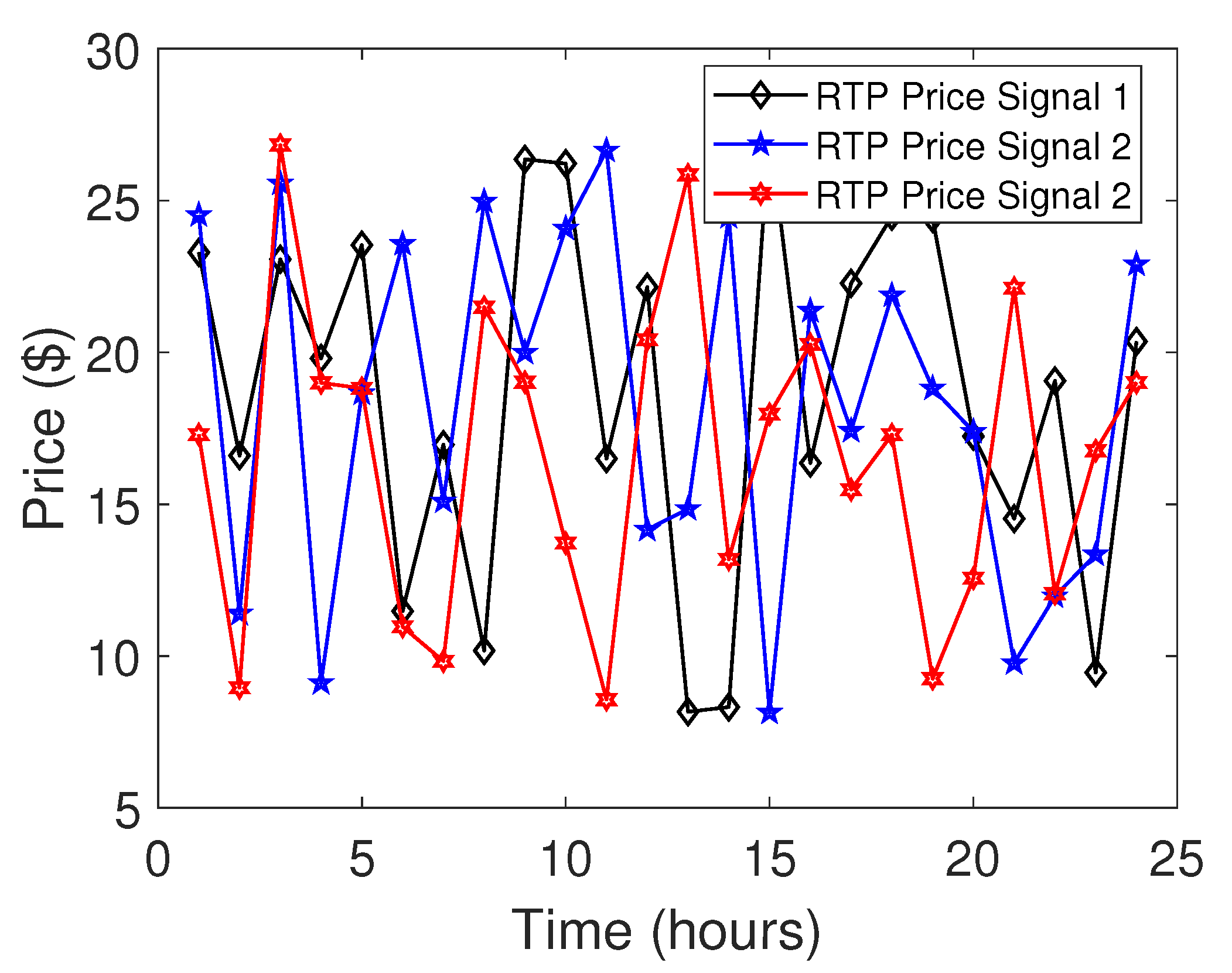
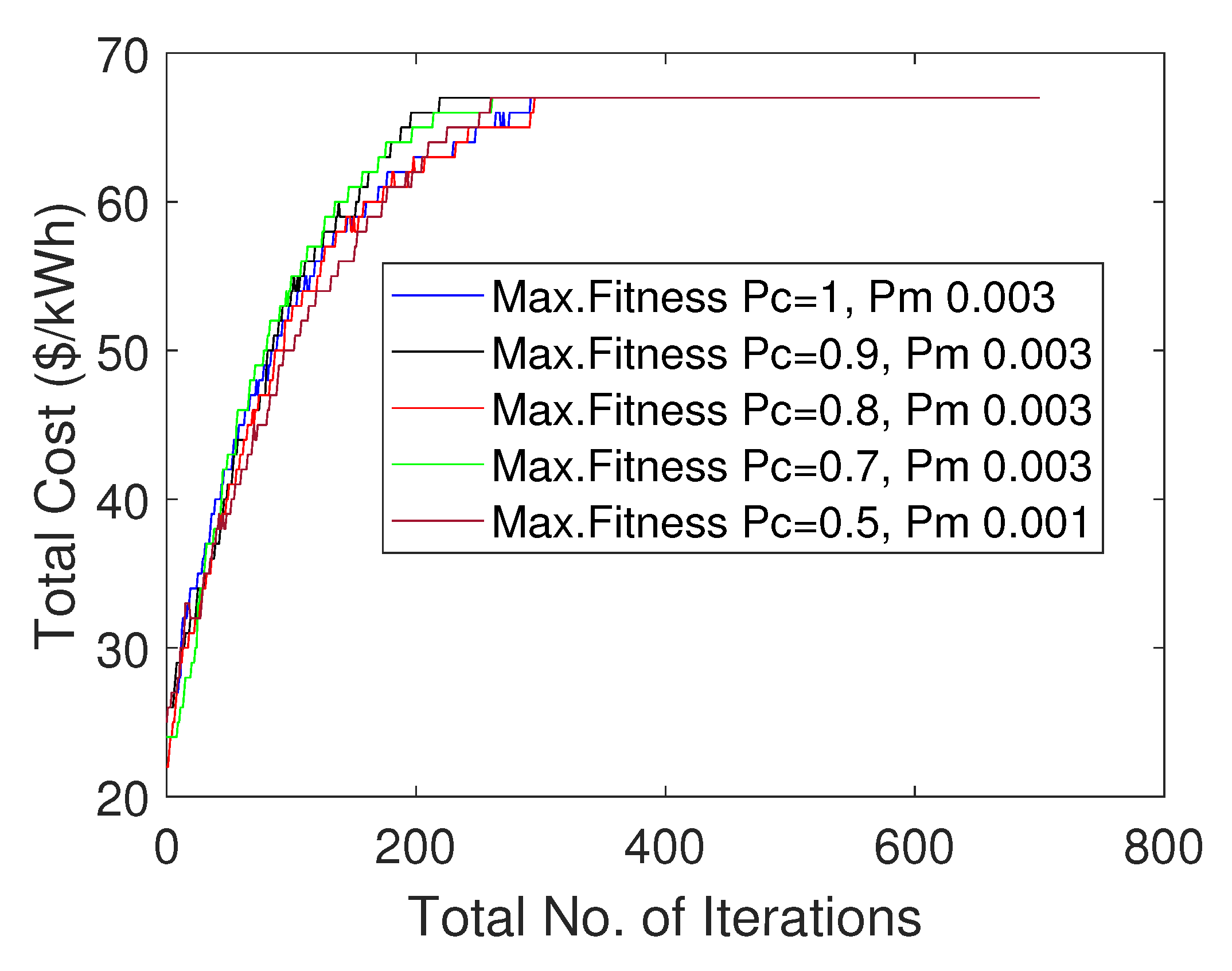
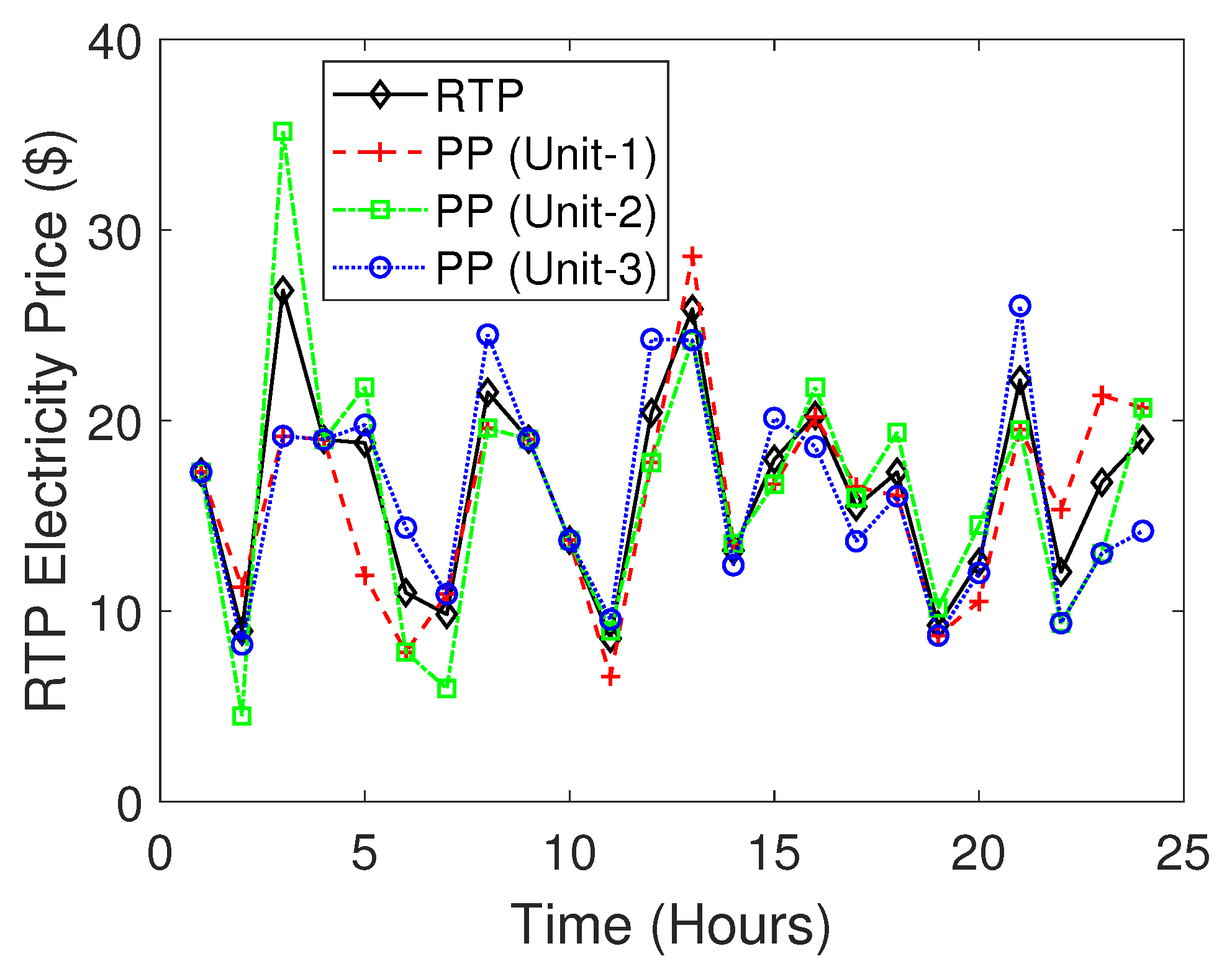
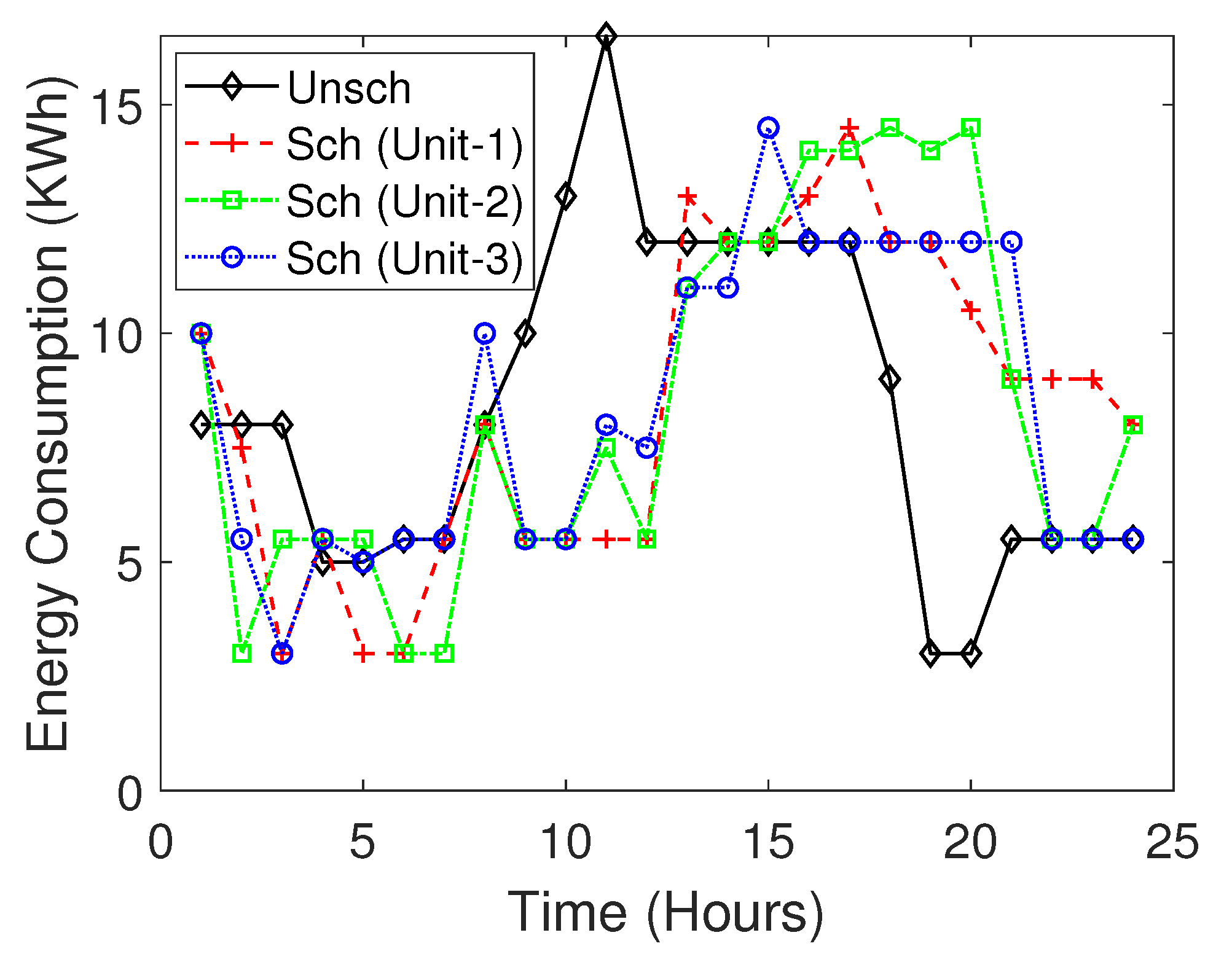
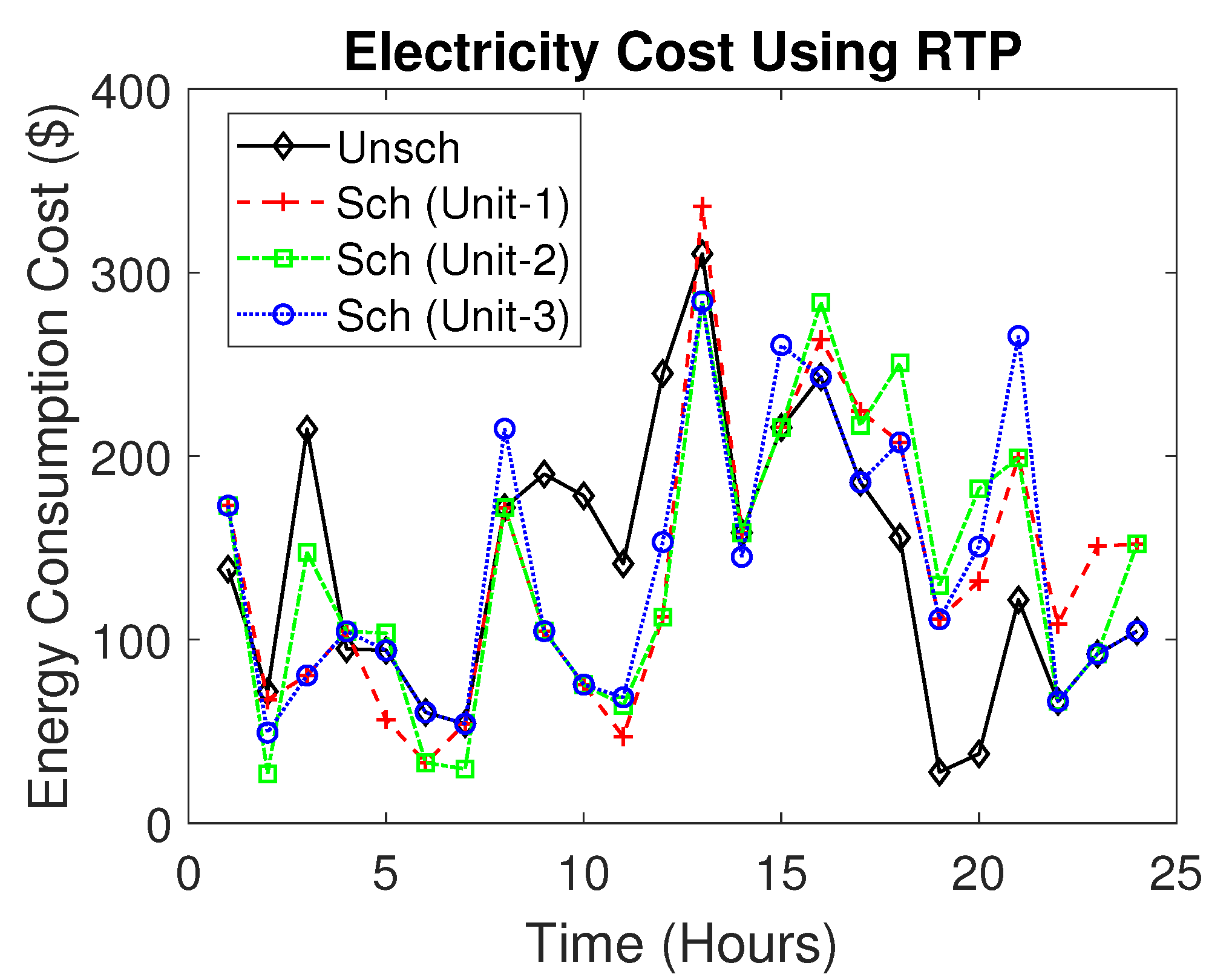
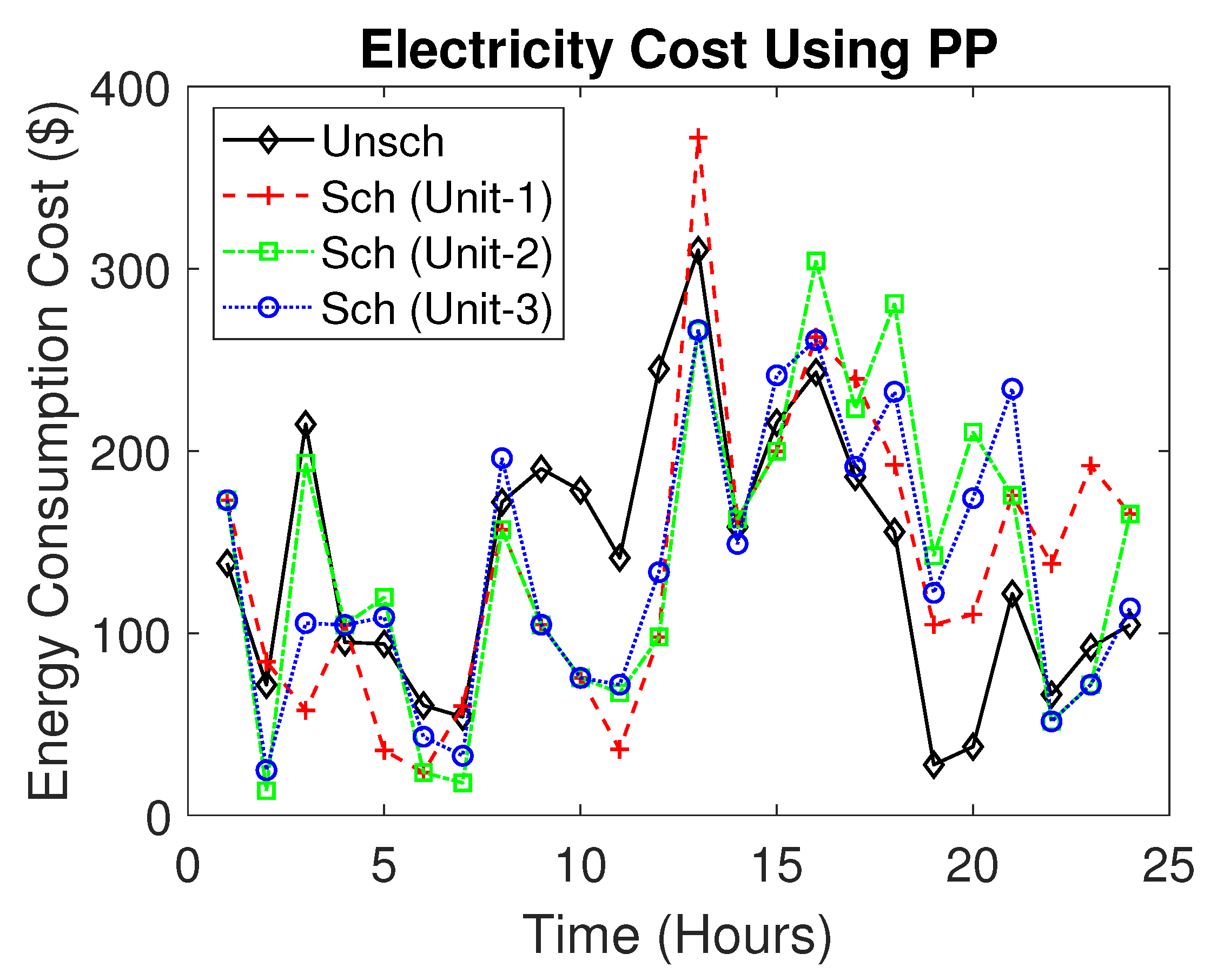
| Working Hours | (kW) | |
|---|---|---|
| 20 | 2.5 | |
| 24 | 3 | |
| 5 | 2 | |
| 7 | 2.5 | |
| 8 | 3.5 | |
| 8 | 3 |
Publisher’s Note: MDPI stays neutral with regard to jurisdictional claims in published maps and institutional affiliations. |
© 2021 by the authors. Licensee MDPI, Basel, Switzerland. This article is an open access article distributed under the terms and conditions of the Creative Commons Attribution (CC BY) license (https://creativecommons.org/licenses/by/4.0/).
Share and Cite
Alquthami, T.; Milyani, A.H.; Awais, M.; Rasheed, M.B. An Incentive Based Dynamic Pricing in Smart Grid: A Customer’s Perspective. Sustainability 2021, 13, 6066. https://doi.org/10.3390/su13116066
Alquthami T, Milyani AH, Awais M, Rasheed MB. An Incentive Based Dynamic Pricing in Smart Grid: A Customer’s Perspective. Sustainability. 2021; 13(11):6066. https://doi.org/10.3390/su13116066
Chicago/Turabian StyleAlquthami, Thamer, Ahmad H. Milyani, Muhammad Awais, and Muhammad B. Rasheed. 2021. "An Incentive Based Dynamic Pricing in Smart Grid: A Customer’s Perspective" Sustainability 13, no. 11: 6066. https://doi.org/10.3390/su13116066
APA StyleAlquthami, T., Milyani, A. H., Awais, M., & Rasheed, M. B. (2021). An Incentive Based Dynamic Pricing in Smart Grid: A Customer’s Perspective. Sustainability, 13(11), 6066. https://doi.org/10.3390/su13116066







